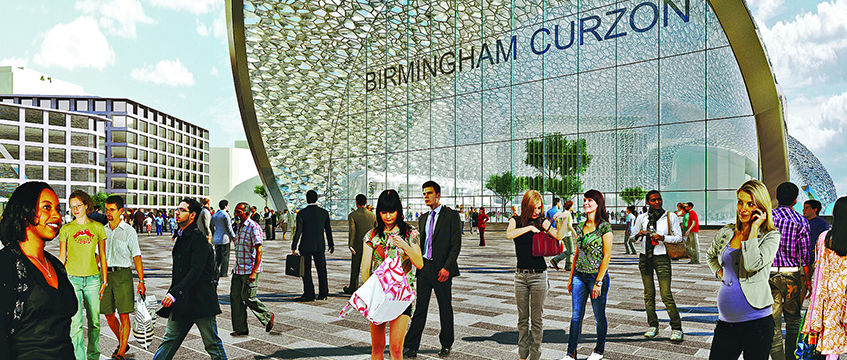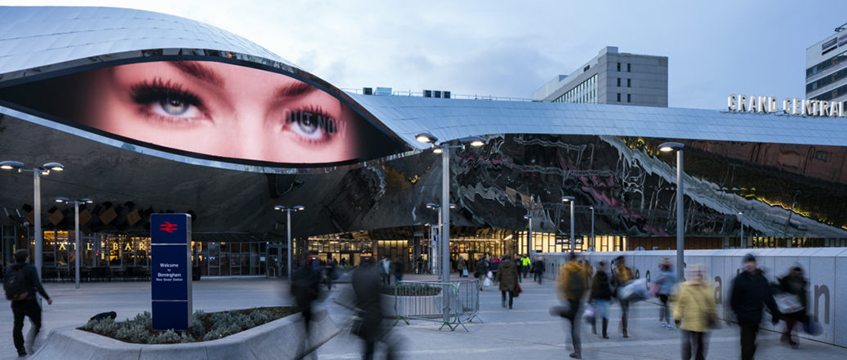In 2003, Country Life readers voted Birmingham’s New Street Station the UK’s ugliest building. The terminus was described as an “airless and confusing warren housing one the country’s most important rail interchanges”.
National Rail spent £750m on a five-year major refurbishment that completed in 2015, creating a new gateway to the city and inviting new investment and global attention. The station is the busiest outside of London, with 42m annual passenger journeys, and following that investment is now home to Hammerson and CPPIB’s £350m, 435,000 sq ft Grand Central shopping centre.
Now Birmingham is readying itself for the next stage of its rail-backed evolution, with HS2 opening the city to high-speed connections to the South. Despite fears for delayed delivery, the real estate world is pressing on.
Investors are signing up to new schemes, planning applications for record-breaking skyscrapers are being prepared and landowners that control 60 acres in Digbeth are creating a vision for the future of that region.
Here EG takes a look into the main areas being propelled forward by the prospective £56bn infrastructure project.

Curzon Street and Eastside
The £56bn railway will make Birmingham the first major port of call outside of London en route to Northern Powerhouse cities in future phases. Birmingham will benefit from two terminals, the Birmingham Interchange seven miles outside the city in Solihull, and the city centre terminal at Curzon Street Station, both of which are set to be operational by 2026.
“If you stand next to the proposed HS2 Curzon concourse, you can see lots of early site activity on the line and the terminus,” says Charles Toogood, senior director and head of the national offices team at GVA. “But it is still very early days and there is little development activity beyond that.”
Although investment in the Curzon Street area has picked up this year, large-scale construction has been limited to Nikal and LaSalle Investment Management’s £350m Masshouse project at Exchange Square.
LaSalle owns the first phase, comprising three towers of up to 27 storeys with 603 build-to-rent flats, due for completion next year. Nikal is revising plans for phase two, with initial adjustments seeking to increase the scheme from 223 to 565 flats in two towers of seven and 46 storeys, this has since been amended and the developer says an update on the plans will be announced shortly.
Court Collaboration bought the CEAC building from Birmingham Metropolitan College in Q1 2018 and has rebranded the development as 1 Eastside. Court is in pre-application discussions seeking to build a BTR residential tower that would be the largest in Birmingham, exceeding Moda Living’s 42-storey scheme in the west, and hopes for consent in Q1 2019, construction to begin in Q2 and completion by 2022.
“It’s the most pre-eminent building as you walk outside what will be the new HS2 station and it will be a full residential scheme,” says chief executive and founder Anthony McCourt.
“Birmingham is a bit behind the curve when you look at cities like Manchester, which are already reaching for 60-odd storeys. However, we think we have the right mix of contractor, forward funder and location for height here.”
Last month, Berkeley’s Birmingham arm, St Joseph, revealed designs for a £200m build on the 2.6-acre Eastside Locks site less than half a mile north of the station. St Joseph acquired the site from Goodman and anticipates completing the project in Q4 2021. Plans unveiled at a public consultation include what is expected to be one of the tallest buildings in Birminhgam. St Joseph will also develop its own new regional head office on the site, relocating from the city centre.

Martineau Galleries
Directly opposite Nikal’s Exchange Square is one of Birmingham’s largest strategic sites: Hammerson’s 6.5-acre Martineau Galleries on Dale End. In 2006, plans were approved for a 2.86m sq ft development, with 915,000 sq ft dedicated to retail, but construction never started and the site has sat unchanged for more than a decade.
As the sole owner of the site, Hammerson has said it will deliver a new masterplan for “comprehensive redevelopment of the site” next to it. The retail REIT is currently working with Birmingham City Council on the masterplan, which will connect with the HS2 terminal and the wider city centre. A revised planning application will follow.
The site was previously earmarked for predominantly retail uses, but as office and residential demand in the city soars and the retail market continues to suffer, it is expected the mix will be dramatically altered.
“It is an important strategic location in the city centre with huge potential,” says Robin Dobson, director of retail development at Hammerson. “The scheme is part of our City Quarters concept, which looks at evolving our venues and landbank beyond pure retail to deliver residential, workspace, cultural and leisure uses, all of which enhance the offer in major cities such as Birmingham.”
Digbeth
South of the terminal, Digbeth landowners are preparing their strategy for large-scale regeneration, almost five years after Birmingham City Council released its Curzon HS2 masterplan. Three major landowners – the Gooch Estate, Homes England and Oval Real Estate – are collaborating to prepare their vision for the next 10 to 25 years.
“We are creating our own Digbeth vision, which is a response to HS2, Smithfield Market and other large bits of infrastructure which are coming through Digbeth,” says Oval managing director James Craig.
The plan which will be delivered in February 2019, pending consultation with stakeholders, will set the strategy for the next 20 years of development in the context of the wider city plans.
“It’s about not rushing it, making sure we do it right. We do it once and we do it properly,” says Craig.
Savills director Barry Allen, who advises the Gooch Estate and Homes England, adds: “It will be a balance between retaining what is good, balancing the forces of change, maximising the opportunity which the area represents in itself and which HS2 brings, and also responding to the fact that HS2, because of its physical scale, will have a significant impact.”
“Gooch is developing at the moment, but there is a huge amount of work to shape what will come forward in the future, and that has involved a number of parties working in collaboration with both Birmingham City Council and HS2 on critical matters such as public realm and accessibility, and on the emerging vision.”
Last year, Gooch appointed Stoford Development to deliver its £200m Typhoo Wharf development adjoining Curzon Street Station.
Homes England is not yet developing.
Oval Real Estate owns 16 acres of land and around 1m sq ft of existing buildings in Digbeth. Craig says it is also in the process of creating a new masterplan for upcoming development in the region.
“It will be a large mixed-use development that captures the grain of the area and continues using the heritage of the area. We want to be the antidote to the city, we are not about glass and steel, but interesting design and future-proofing older buildings,” says Craig.
HS2 Ltd has been working closely with the council and landowners to maximise regeneration opportunities and development, and has commissioned its own site-wide masterplan, which will commence development in early 2019, once the station design is fixed.
Birmingham City Council is conducting a review of local conservation areas and will consult on supplementary planning documents early next year, with the focus on supporting regeneration, responding to the heritage and nature of the regions.
To send feedback, e-mail emma.rosser@egi.co.uk or tweet @EmmaARosser or @estatesgazette











